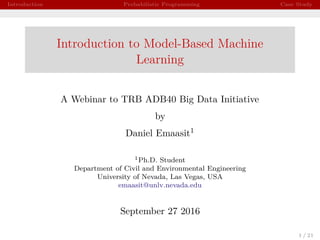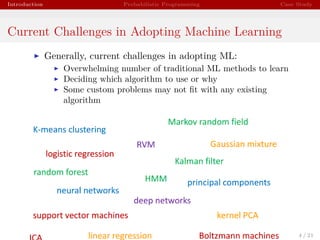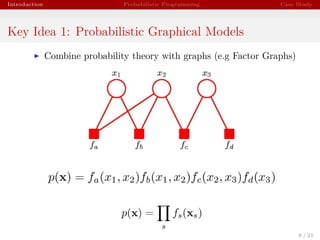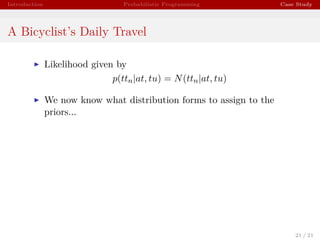Introduction to Model-Based Machine Learning for Transportation
- 1. Introduction Probabilistic Programming Case Study Introduction to Model-Based Machine Learning A Webinar to TRB ADB40 Big Data Initiative by Daniel Emaasit1 1Ph.D. Student Department of Civil and Environmental Engineering University of Nevada, Las Vegas, USA [email protected] September 27 2016 1 / 21
- 2. Introduction Probabilistic Programming Case Study Acknowledgments1 Prof. Francisco C. Pereira Dr. Filipe Rodrigues 1 Machine Learning for Mobility group, DTU: Tutorial from Summer school on Big Data, Mobility Patterns, Transport Analytics, July 1-3, 2016, Filipe Rodrigues and Francisco Pereira 2 / 21
- 3. Introduction Probabilistic Programming Case Study Introduction 3 / 21
- 4. Introduction Probabilistic Programming Case Study Current Challenges in Adopting Machine Learning Generally, current challenges in adopting ML: Overwhelming number of traditional ML methods to learn Deciding which algorithm to use or why Some custom problems may not fit with any existing algorithm 4 / 21
- 5. Introduction Probabilistic Programming Case Study What is Model-Based Machine Learning? A different viewpoint for machine learning proposed by Bishop (2013)2, Winn et al. (2015)3 * Goal: + Provide a single development framework which supports the creation of a wide range of bespoke models * The core idea: + all assumptions about the problem domain are made explicit in the form of a model 2 Bishop, C. M. (2013). Model-Based Machine Learning. Philosophical Transactions of the Royal Society A, 371, pp 1–17 3 Winn, J., Bishop, C. M., Diethe, T. (2015). Model-Based Machine Learning. Microsoft Research Cambridge. http://www.mbmlbook.com. 5 / 21
- 6. Introduction Probabilistic Programming Case Study What is a Model in MBML? A Model: is a set of assumptions, expressed in mathematical/graphical form expresses all parameters, variables as random variables shows the dependency between variables Figure 2: Description of a model 6 / 21
- 7. Introduction Probabilistic Programming Case Study Key Ideas of MBML? MBML is built upon 3 key ideas the use of Probabilistic Graphical Models (PGM) the adoption of Bayesian ML the application of fast, deterministic inference algorithms 7 / 21
- 8. Introduction Probabilistic Programming Case Study Key Idea 1: Probabilistic Graphical Models Combine probability theory with graphs (e.g Factor Graphs) 8 / 21
- 9. Introduction Probabilistic Programming Case Study Key Idea 2: Bayesian Machine Learning Everything follows from two simple rules of probability theory 9 / 21
- 10. Introduction Probabilistic Programming Case Study Key Idea 3: Inference Algorithms the application of fast, approximate inference algorithms by local message passing Variational Bayes Belief Propagation, Loopy Belief Propagation Expectation Propagation Learning by local message passing Inference algorithms Figure 3: MCMC vs Approximate methods 10 / 21
- 11. Introduction Probabilistic Programming Case Study Stages of MBML 3 stages of MBML Build the model: Joint probability distribution of all the relevant variables (e.g as a graph) Incorporate the observed data Perform inference to learn parameters of the latent variables 11 / 21
- 12. Introduction Probabilistic Programming Case Study Special cases of MBML Special cases For sequential data 12 / 21
- 13. Introduction Probabilistic Programming Case Study Benefits of MBML Potential benefits of this approach Provides a systematic process of creating ML solutions Allows for incorporation of prior knowledge Allows for handling uncertainity in a principled manner Does not suffer from overfitting Custom solutions are built for specific problems Allows for quick building of several alternative models Easy to compare those alternatives It’s general purpose: No need to learn the 1000s of existing ML algorithms Separates model from inference/training code 13 / 21
- 14. Introduction Probabilistic Programming Case Study Probabilistic Programming 14 / 21
- 15. Introduction Probabilistic Programming Case Study What is Probabilistic Programming? A software package that takes the model and then automatically generate inference routines (even source code!) to solve a wide variety of models Takes programming languages and adds support for: random variables constraints on variables inference Examples of PP software packages Infer.Net (C#, C++) Stan (R, python, C++) BUGS church PyMC (python) 15 / 21
- 16. Introduction Probabilistic Programming Case Study How Probabilistic Programming works Figure 5: How infer.NET works 16 / 21
- 17. Introduction Probabilistic Programming Case Study Case Study 17 / 21
- 18. Introduction Probabilistic Programming Case Study A Bicyclist’s Daily Travel Analysing the distribution of an individual cyclist’s daily travel time to work 18 / 21
- 19. Introduction Probabilistic Programming Case Study A Bicyclist’s Daily Travel Analysing the distribution of an individual cyclist’s daily travel time to work Identify the variables of interest ttn - travel time in the nth day at - average travel-time tu - uncertainty ttn at tu N 18 / 21
- 20. Introduction Probabilistic Programming Case Study A Bicyclist’s Daily Travel Analysing the distribution of an individual cyclist’s daily travel time to work Specify relationships between variables ttn - travel time in the nth day at - average travel-time tu - uncertainty ttn at tu N 19 / 21
- 21. Introduction Probabilistic Programming Case Study A Bicyclist’s Daily Travel Analysing the distribution of an individual cyclist’s daily travel time to work Specify relationships between variables ttn - travel time in the nth day at - average travel-time tu - uncertainty ttn at tu N Joint distribution is given by p(tt, at, tu) = p(at) p(tu) priors × N n=1 p(ttn|at, tu) likelihood 19 / 21
- 22. Introduction Probabilistic Programming Case Study A Bicyclist’s Daily Travel Analysing the distribution of an individual cyclist’s daily travel time to work Joint distribution is given by p(tt, as, tu) = p(at) p(tu) priors × N n=1 p(ttn|at, tu) likelihood How should we define the likelihood p(ttn|at, tu)? 20 / 21
- 23. Introduction Probabilistic Programming Case Study A Bicyclist’s Daily Travel Analysing the distribution of an individual cyclist’s daily travel time to work Joint distribution is given by p(tt, as, tu) = p(at) p(tu) priors × N n=1 p(ttn|at, tu) likelihood How should we define the likelihood p(ttn|at, tu)? the distribution’s mean is the cyclist’s average travel time the distribution’s variance determines how much the travel time varies from day to day (e.g. variations in traffic conditions) 20 / 21
- 24. Introduction Probabilistic Programming Case Study A Bicyclist’s Daily Travel Analysing the distribution of an individual cyclist’s daily travel time to work Joint distribution is given by p(tt, as, tu) = p(at) p(tu) priors × N n=1 p(ttn|at, tu) likelihood How should we define the likelihood p(ttn|at, tu)? the distribution’s mean is the cyclist’s average travel time the distribution’s variance determines how much the travel time varies from day to day (e.g. variations in traffic conditions) What distributions should p(at) and p(tu) have? 20 / 21
- 25. Introduction Probabilistic Programming Case Study A Bicyclist’s Daily Travel Analysing the distribution of an individual cyclist’s daily travel time to work Joint distribution is given by p(tt, as, tu) = p(at) p(tu) priors × N n=1 p(ttn|at, tu) likelihood How should we define the likelihood p(ttn|at, tu)? the distribution’s mean is the cyclist’s average travel time the distribution’s variance determines how much the travel time varies from day to day (e.g. variations in traffic conditions) What distributions should p(at) and p(tu) have? conjugate priors! 20 / 21
- 26. Introduction Probabilistic Programming Case Study A Bicyclist’s Daily Travel Likelihood given by p(ttn|at, tu) = N(ttn|at, tu) We now know what distribution forms to assign to the priors... 21 / 21
- 27. Introduction Probabilistic Programming Case Study A Bicyclist’s Daily Travel Likelihood given by p(ttn|at, tu) = N(ttn|at, tu) We now know what distribution forms to assign to the priors... p(at) = N(at|µ, σ2 ) p(tu) = cauchy(tu|µ, σ2 ) 21 / 21
- 28. Introduction Probabilistic Programming Case Study A Bicyclist’s Daily Travel Likelihood given by p(ttn|at, tu) = N(ttn|at, tu) We now know what distribution forms to assign to the priors... p(at) = N(at|µ, σ2 ) p(tu) = cauchy(tu|µ, σ2 ) The choice of the initial parameters of the prior is significant only if you have a small number of observations As the number of observations increases, the influence of the initial prior on the posterior declines 21 / 21




























